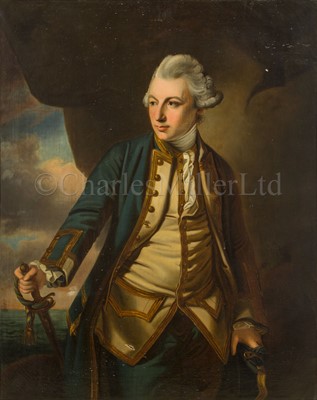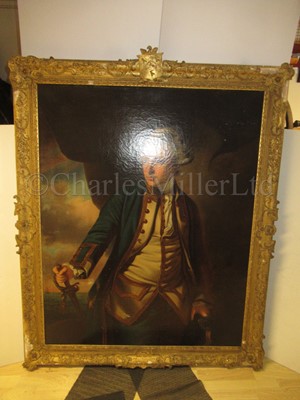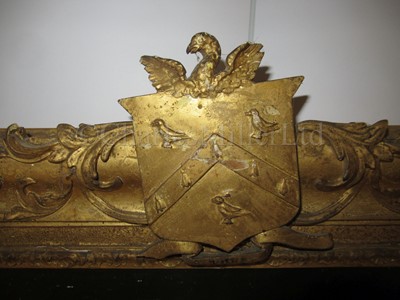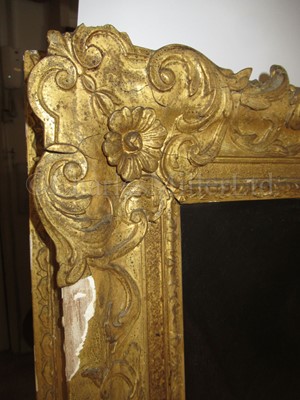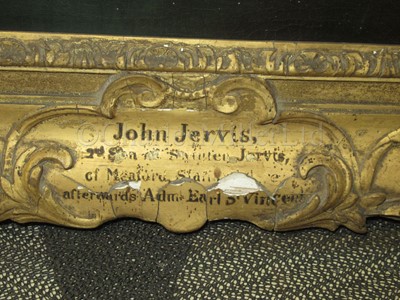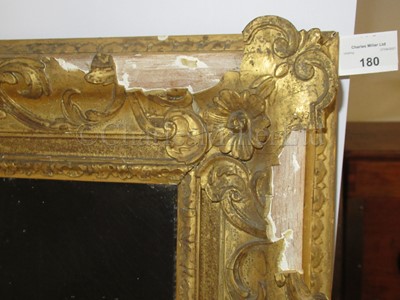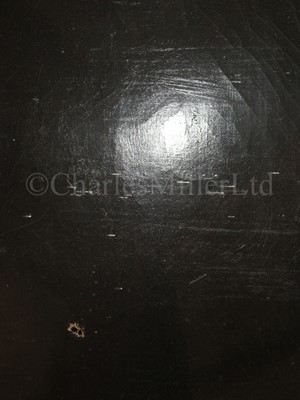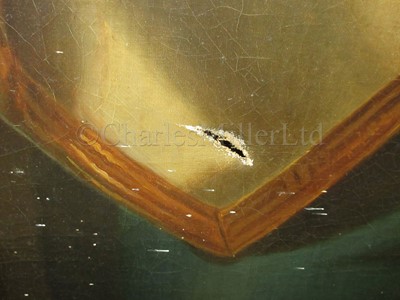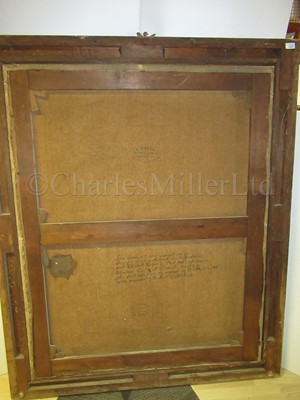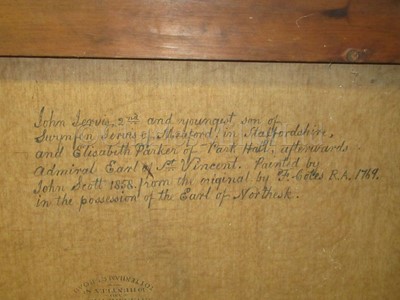27th Apr, 2021 10:00
Maritime and Scientific Models, Instruments & Art (Untiring)
180
[M] AFTER FRANCIS COATES (19TH CENTURY) : Portrait of John Jervis, Earl of St Vincent circa 1769
AFTER FRANCIS COATES (19TH CENTURY)
Portrait of John Jervis, Earl of St.Vincent, circa 1769
Oil on canvas
49 x 39in. (124.5 x 99cm.)
Provenance: John Jervis, The Earl St. Vincent (1735-1833), Meaford Hall (removed 1943 when Hall sold), and thence by descent.
The source painting is located at the National Portrait Gallery, No. NPG2026
Admiral of the Fleet the Right Honourable Sir John Jervis, Earl of St. Vincent (1735-1823) was one of the most towering naval personalities of the 18th century and it was largely due to him that Nelson’s abilities were recognized and rewarded.
Born in Meaford, Staffordshire, his parents moved to Greenwich when his father was appointed Solicitor to the Admiralty and Treasurer of Greenwich Hospital whilst John was still a child. His father wanted him to go into the Law, but John determined on a career at sea and, after much parental opposition, entered the navy on 4th January 1749 as an able seaman in the 50-gun 4th rate H.M.S. Gloucester. After seeing action in the Mediterranean and North America in the Seven Years’ War (1756-63), his promotion to Captain came in 1760. When he participated in the battle of Ushant in July 1778, he was in command of the 80-gun Foudroyant and went on to distinguish himself on several occasions during the later stages of the American War of Independence, most notably on all three of the expeditions to relieve Gibraltar. After the War, he entered politics, became an M.P. and married, and in 1787 was promoted rear-admiral.
In the general promotion following the outbreak of war with Revolutionary France, he was made vice-admiral (1st February 1793) and his first wartime appointment was to command the fleet sent to secure Britain’s West Indian possessions. After initially capturing the French islands of Martinique and Guadeloupe in successful amphibious operations in cooperation with General Sir Charles Grey, Guadeloupe was quickly recaptured by the French and Jervis returned home with his reputation somewhat tarnished. Despite this temporary setback, he was nevertheless promoted to Admiral in June 1795 and was appointed to one of the most prestigious commands in the navy, namely the Mediterranean fleet. This was already a perilous time for Britain and, once Spain entered the war on the French side, the situation in the Mediterranean became graver still, to the extent that Jervis was soon forced to withdraw his fleet to the safety of the Tagus at Lisbon. From there, Jervis could monitor the Spanish fleet’s activities and it was from here that he emerged to confront the Spaniards off Cape St. Vincent in February 1797. In recognition of his great victory against such superior odds, he was elevated to the peerage as Earl of St. Vincent the following June.
In the wake of Nelson’s daring at the recent battle, St. Vincent’s subsequent support for his protégé is well-documented, but it did sometimes cause friction with several of St. Vincent’s fellow flag officers. Moreover, as he grew older, St. Vincent’s temper often got the better of him and reached a point in 1800 when the King had to forbid all the infighting at the Admiralty. St. Vincent’s health was also rather indifferent at this time, but he was still given command of the Channel fleet and kept an exemplary blockade of Brest from May to September 1800. With the formation of a new government early in 1801, St. Vincent accepted the role of First Lord of the Admiralty, a position he held until another change of government forced him to resign in May 1804. After William Pitt’s death in January 1806, St. Vincent agreed to return to sea to command the Channel fleet, but his failing health and the collapse of the new administration led to his official retirement in March 1807. Occasionally seen in the House of Lords thereafter, he was created G.C.B. in January 1815 and finally appointed Admiral of the Fleet in July 1821. He died in March 1823, aged eighty-eight, and as he was childless, the earldom became extinct although his viscountcy devolved to his only surviving nephew, Edward Jervis Ricketts.
Sold for £14,880
Estimated at £1,500 - £2,500
(inc. buyer's premium of 24%)
Condition Report
Needs to be cleaned, 2 holes, paint chipping, would benefit from a re-line.
We are pleased to provide you with a general report of the condition of this property. Since we are not professional conservators or restorers, we urge you to consult with a restorer or conservator of your choice who will be better able to provide a detailed, professional report. Prospective buyers should inspect each lot to satisfy themselves as to condition and must understand that any statement made by Charles Miller Ltd is merely a subjective, qualified opinion. Prospective buyers should also refer to any Important Notices regarding this sale, which are printed in the Sale Catalogue. NOTWITHSTANDING THIS REPORT OR ANY DISCUSSIONS CONCERNING A LOT, ALL LOTS ARE OFFERED AND SOLD “AS IS” IN ACCORDANCE WITH THE CONDITIONS OF BUSINESS PRINTED IN THE SALE CATALOGUE.
AFTER FRANCIS COATES (19TH CENTURY)
Portrait of John Jervis, Earl of St.Vincent, circa 1769
Oil on canvas
49 x 39in. (124.5 x 99cm.)
Provenance: John Jervis, The Earl St. Vincent (1735-1833), Meaford Hall (removed 1943 when Hall sold), and thence by descent.
The source painting is located at the National Portrait Gallery, No. NPG2026
Admiral of the Fleet the Right Honourable Sir John Jervis, Earl of St. Vincent (1735-1823) was one of the most towering naval personalities of the 18th century and it was largely due to him that Nelson’s abilities were recognized and rewarded.
Born in Meaford, Staffordshire, his parents moved to Greenwich when his father was appointed Solicitor to the Admiralty and Treasurer of Greenwich Hospital whilst John was still a child. His father wanted him to go into the Law, but John determined on a career at sea and, after much parental opposition, entered the navy on 4th January 1749 as an able seaman in the 50-gun 4th rate H.M.S. Gloucester. After seeing action in the Mediterranean and North America in the Seven Years’ War (1756-63), his promotion to Captain came in 1760. When he participated in the battle of Ushant in July 1778, he was in command of the 80-gun Foudroyant and went on to distinguish himself on several occasions during the later stages of the American War of Independence, most notably on all three of the expeditions to relieve Gibraltar. After the War, he entered politics, became an M.P. and married, and in 1787 was promoted rear-admiral.
In the general promotion following the outbreak of war with Revolutionary France, he was made vice-admiral (1st February 1793) and his first wartime appointment was to command the fleet sent to secure Britain’s West Indian possessions. After initially capturing the French islands of Martinique and Guadeloupe in successful amphibious operations in cooperation with General Sir Charles Grey, Guadeloupe was quickly recaptured by the French and Jervis returned home with his reputation somewhat tarnished. Despite this temporary setback, he was nevertheless promoted to Admiral in June 1795 and was appointed to one of the most prestigious commands in the navy, namely the Mediterranean fleet. This was already a perilous time for Britain and, once Spain entered the war on the French side, the situation in the Mediterranean became graver still, to the extent that Jervis was soon forced to withdraw his fleet to the safety of the Tagus at Lisbon. From there, Jervis could monitor the Spanish fleet’s activities and it was from here that he emerged to confront the Spaniards off Cape St. Vincent in February 1797. In recognition of his great victory against such superior odds, he was elevated to the peerage as Earl of St. Vincent the following June.
In the wake of Nelson’s daring at the recent battle, St. Vincent’s subsequent support for his protégé is well-documented, but it did sometimes cause friction with several of St. Vincent’s fellow flag officers. Moreover, as he grew older, St. Vincent’s temper often got the better of him and reached a point in 1800 when the King had to forbid all the infighting at the Admiralty. St. Vincent’s health was also rather indifferent at this time, but he was still given command of the Channel fleet and kept an exemplary blockade of Brest from May to September 1800. With the formation of a new government early in 1801, St. Vincent accepted the role of First Lord of the Admiralty, a position he held until another change of government forced him to resign in May 1804. After William Pitt’s death in January 1806, St. Vincent agreed to return to sea to command the Channel fleet, but his failing health and the collapse of the new administration led to his official retirement in March 1807. Occasionally seen in the House of Lords thereafter, he was created G.C.B. in January 1815 and finally appointed Admiral of the Fleet in July 1821. He died in March 1823, aged eighty-eight, and as he was childless, the earldom became extinct although his viscountcy devolved to his only surviving nephew, Edward Jervis Ricketts.
Auction: Maritime and Scientific Models, Instruments & Art (Untiring), 27th Apr, 2021
Mercantile (Sail) 1-123
Mercantile (Steam) 124-166
Naval (Sail) 170-252
Naval (Steam) 255-339
Navigational & Scientific Instruments 340-395
--
Printed catalogues available at £20 (+P&P)
--
--
THIS SALE WILL BE CONDUCTED LIVE ONLINE ONLY
You will not be able to bid live in the room. Absentee bids may be left via the website or using a bid form or you can bid via one of three online platforms. Absentee bids on our site must be left by 9am on the morning of the sale. Unfortunately, we cannot offer telephone bidding for this sale
- UKAuctioneers.com – this service offers a choice of either paying a one-off £3.95 flat fee for the sale and no further charges, or 3% of the hammer price. Charles Miller Ltd will refund successful buyers who bid via the £3.95 flat fee
- The-Saleroom.com – charges 5% of the hammer price
- Invaluable.com – charges 3% of the hammer price
Viewing
By appointment only, please call or email
enquiries@charlesmillerltd.com
+44 (0)20 7806 5530

